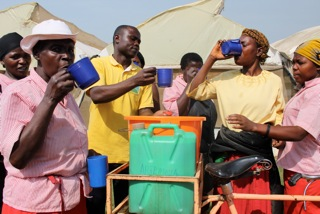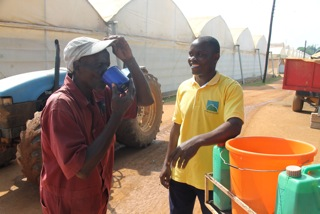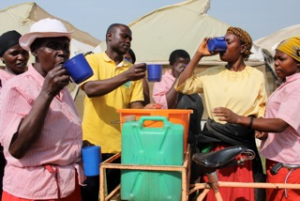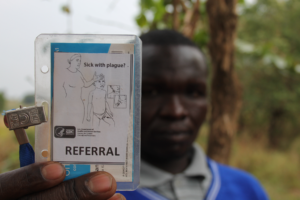



ENTEBBE, Uganda—It’s a little after 9 a.m. on the Wagagai Flower Farm, and Robert Watsusi pedals a bicycle laden with two 3-gallon jugs of a hot, bitter black tea. As he rounds a corner, workers emerge from football field–size growing houses to imbibe their weekly dose of the elixir they say keeps them free from malaria. “When I see people taking it, I feel happy,” says Watsusi. “It is very good for everyone.”
The tea comes from sweet wormwood (Artemisia annua), the Chinese plant that is a source for the world’s most powerful anti-malarial treatments, which combine artemisinin derivatives with an older class of drugs. It can also be grown in wetter parts of Africa, and a year’s supply costs no more than a few dollars. Although the tea itself has traditionally been used in treatment, not prevention, in China, a randomized controlled trial on this farm showed that workers who drank it regularly reduced their risk of suffering from multiple episodes of malaria by one-third. For a group of people who were once waylaid by this mosquito-borne disease four or more times per year, the tea is a godsend.
Which is why you may be surprised to learn that the World Health Organization and a majority of malaria researchers are adamantly opposed to it. To be fair, there are compelling reasons not to endorse an herbal tea in a fight against a potentially deadly disease. After all, conventional single-molecule drugs are honed through chemistry to be safer, more specific, and more effective than their herbal progenitors. More critically, malaria experts worry that unregulated use of this tea could cause the malaria parasite to develop resistance to artemisinin drugs.
But the tea’s mere existence and its rapid spread challenges the view that conventional pharmaceuticals are the best and only way of managing Africa’s health care problems. After all, experts in the international aid world talk a lot about sustainability, and nothing is more sustainable than a drug grown on a shrub.
Of all the illnesses that have afflicted humanity over millennia, few have left their mark quite like malaria, which infects 200 million people each year and kills at least 655,000, most of whom are children. Falciparum malaria—the most common type in sub-Saharan Africa—starts as a debilitating fever, which can progress in severe cases to convulsions, brain damage, and death. In this part of the world, it’s almost impossible to stay completely free of the parasites for long. Adults often display a low level of immunity, which makes each subsequent infection painful and unpleasant but usually not fatal.
The story of artemisinin demonstrates that even the best malaria drugs are worthless if they are not getting to the people who need them. In the late 1990s, African malaria parasites had become resistant to standard treatments such as chloroquine, and malaria deaths in Uganda doubled in a decade. By the early 2000s, there was a proven alternative: artemisinin combination therapies. Nevertheless, the Global Fund for AIDS, Tuberculosis, and Malaria repeatedly rejected countries’ requests for money for ACTs, funding failing treatments over ACTs at a rate of 10-to-1. In 2004, a group of fed-up scientists writing in the Lancet called these decisions “medical malpractice.” Today, although ACTs are heavily subsidized by the international aid community, local clinics frequently run out of stock, and Africans often end up with substandard, ineffective, and sometimes counterfeit medications.
Long before ACTs were available in Uganda, rumors of Artemisia’s powers began to spread. In 1998, a German organization called Action for Natural Medicine (Anamed) began distributing seeds and cuttings from Artemisia, including a potent hybrid called A3, in 75 different countries.
One day in the town of Masaka, I met an enthusiastic Ugandan woman named Rehema Namyalo, who founded the local Anamed outpost and makes her living advising her neighbors and selling herbal treatments. After giving a tour of her medicinal garden, she unfurled colorful, handmade posters. One read, “Making A3 Leaf Tea for Malaria Treatment for Adult of Weight 50kg+.” Another illustrates the proper spacing for Artemisia plants in a field.
However, no organization I know of has taken things quite as far as the Dutch-owned Wagagai Flower Farm. In 2005, the farm’s owners were struggling because more than one-third of their 1,500 workers were falling ill with malaria each year. The Tororo Botanical Garden in Fort Portal provided Artemisiaseeds, and the owners began distributing the tea for free—not for treatment but for prevention of malaria episodes. Soon afterward, a researcher named Patrick Ogwang with the Ugandan Ministry of Health documented a decline of malaria incidence among almost 300 workers drinking the tea, and followed up with the randomized controlled trial demonstrating the tea’s effectiveness. Today, workers like Peter Osire, an irrigation supervisor, tell me it has been years since they had a fever.
While the workers are effusive about the tea, malaria experts have taken less kindly to it. When Ogwang tried to publish the results in Malaria Journal, a reviewer largely praised the quality of the science but nixed publication out of concern that use of the tea could render ACTs ineffective. It’s a remarkably patronizing recommendation: that a scientific journal should keep the latest evidence out of the hands of Africans, lest they begin treating themselves. Marcel Hommel, editor in chief of the journal, defends the decision, saying, “It is the responsibility of an editor to avoid publishing papers that promote interventions which could potentially put patients at risk.” Ogwang eventually published his results in a less prestigious journal.
It’s hard to see what the risk to individual patients is, since many Ugandans are already using other, unproven herbs from their backyards, and the Artemisia programs have been in place for years. The tea has become widespread enough that last year the WHO published a statement opposing it for either treatment or prevention of malaria, and an online survey of malaria experts found that 72 percent were opposed to its use in prevention. Their view is that low-dose, persistent use could breed resistance, which would be disastrous. But we’re not talking about pumping pigs full of unnecessary antibiotics. We’re talking about desperate people trying to live normal lives. And, in Wagagai, after years of preventive use, resistance has not sprung up.
Ogwang says that may be because the tea, like other herbal products, contains multiple active compounds besides artemisinin. Cinchona bark is still effective after hundreds of years even though chloroquine (a derivative) is not. The Chinese have been using wormwood for more than 1,500 years for a variety of ailments, but the only place where we’ve seen signs of artemisinin resistance is on the Thai-Cambodian border, where conventional artemisinin drugs are used with abandon. If the goal is really to reserve these last-resort drugs for treatment rather than for prevention, then why do American and European doctors gladly prescribe Malarone—the only effective artemisinin alternative in some areas—for a romp around Southeast Asia? Nevertheless, Ogwang is now trying to test whether the tea remains effective for prevention even if the artemisinin is eliminated, an idea that sounds crazy but that could eliminate the objection that the tea could stimulate resistance.
It’s tempting to envision a future Africa with all the technology and resources of the Western world, and it’s demeaning to imagine anything else. You could say that herbal drugs are a second-rate health system, and, indeed, it would be irresponsible to recommend an herbal therapy where a conventional alternative exists and is readily available. The fact is that most traditional herbal remedies are probably useless, potentially dangerous, and will only delay a person’s efforts to seek proper medical treatment. But some herbs do have medically active compounds, albeit with varying levels of efficacy, and Africans are choosing to go that route because they know that drug supply won’t be cut off by war or corruption or bureaucratic incompetence. Herbs are not always going to be the right strategy, but the data about these unconventional interventions should be shared and discussed.
In the case of malaria, Anamed and others also argue that it makes sense to preserve stocks of conventional drugs for children and severe cases. One reason ACTs have been so expensive is the cost of isolating artemisinin, but there have long been indications that using a cruder, cheaper whole-plant extract could potentially be more effective and cheaper. In a study conducted in rats last year, University of Massachusetts researchers compared a single dose of pure artemisinin to dried whole leaves, and found that the whole plant was better at killing malaria parasites. And while millions have been spentbioengineering bacteria to crank out pure artemisinin on a budget, you still have to get it to the people who need it.
When you’re just brewing tea on a flower farm, all that means is a short bike ride from the kitchen to the chrysanthemums. “Doctor, doctor!” yells a tall man named Bob Muteso. He takes a plastic cup from Robert Watsusi and tosses it back. Then, he looks over at me and smiles. “He is our African doctor,” he says.
The report also was published in Slate.


